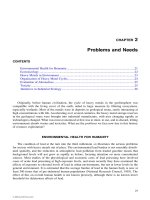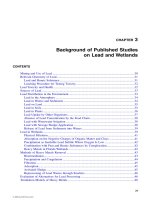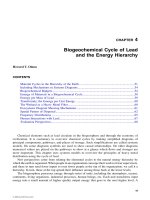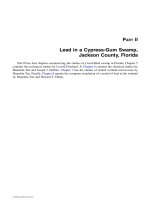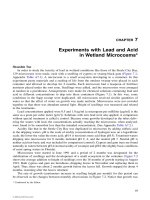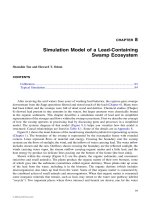Heavy Metals in the Environment: Using Wetlands for Their Removal - Chapter 7 doc
Bạn đang xem bản rút gọn của tài liệu. Xem và tải ngay bản đầy đủ của tài liệu tại đây (235.75 KB, 3 trang )
87
CHAPTER
7
Experiments with Lead and Acid
in Wetland Microcosms*
Shanshin Ton
In order to study the toxicity of lead in wetland conditions like those of the Steele City Bay,
129 microcosms were made, each with a seedling of cypress or swamp black gum (Figure 7.1;
Appendix Table A7.1). A microcosm is a small ecosystem developing in a container. In this
experiment peaty materials and a seeding of life from the outdoor swamp were placed in each
container and allowed to develop for 2 months. Each microcosm had a teaspoon of fertilizer
nutrients placed under the root zone. Seedlings were added, and the microcosms were arranged
at random in a greenhouse. Arrangements were made for chemical solutions containing lead and
acid in different concentrations to drip into these containers (Figure 7.1). In this way, some
conditions in the Sapp swamp were duplicated. All microcosms received similar quantities of
water so that the effect of water on growth was made uniform. Microcosms were not crowded
together so that there was abundant natural light. Height of seedlings was measured and related
to the treatments.
Lead concentrations applied were 0.5 and 1.0
µ
g/ml (a microgram per milliliter [
µ
g/ml] is the
same as a gram per cubic meter [g/m
3
]). Solutions with zero lead were also applied. A comparison
without special treatment is called a control. Because some growths developed in the tubes deliv-
ering the waters with lead, the concentrations actually reaching the microcosms, when analyzed,
were found to be somewhat less than the intended concentration. (See Appendix Table A7.2.)
Acidity like that in the Steele City Bay was duplicated in microcosm by adding sulfuric acid
to the dripping waters. pH is the scale of acidity (concentration of hydrogen ions on a logarithmic
scale; the lower the value the more acid; pH 4 is ten times more acid than pH 5). Treatment waters
dripping into microcosms for 8 months included pH 2, 4, and the neutral pH 7. Neutral pH is
neither acid nor basic and was included for comparison (control). Cypress and gum trees are found
naturally in waters between pH 4 (normal acidity of swamps) and pH 8 (the slightly basic conditions
of most spring waters in Florida).
Microcosms were started in June 1991 and a period of 2 months was designated for the
stabilization of seedlings and the development of a small ecosystem in the container. Figure 7.2
shows the average addition to height of seedlings over the 16 months of growth starting in August
1991. Both cypress and gum are deciduous, dropping leaves in November and replacing them in
April. Thus, there was about 2 months growth before the leaves fell. Growth stopped for about 4
months, resuming after the leaves returned.
The rate of growth (centimeters increase in seedling height per month) for this period can
be observed as the changes between monthly observations in Figure 7.2. Notice that growth was
* Condensed by the Editor.
L1401-frame-C7 Page 87 Monday, April 10, 2000 9:46 AM
© 2000 by CRC Press LLC
88 HEAVY METALS IN THE ENVIRONMENT: USING WETLANDS FOR THEIR REMOVAL
moderate at first during the autumn months when light was less, stopping during the leafless
winter months, accelerating during the summer, and stopping again during the next winter. Under
these conditions, the gum seedlings were slow to start growth and the cypress were slightly taller
at the end. As often observed when new seedlings are planted, growth accelerates as the leaf
area and root systems increase, capturing more sunlight for photosynthesis and transpiration
(processing of water from roots through microscopic leaf holes into the air, keeping leaves cool
and drawing up nutrients).
At the end of the summer of the second year, growth stopped 3 months before the normal time
for leaf fall. This may be due to a combination of nutrient limitation and water stress which result
from higher respiration rate of rapidly growing seedlings during summer months. Due to the large
size of the seedlings and the hypothesis of nutrient limitation and water stress, I cut the seedlings
to their original height before the next growing season. They did regrow in the third year from
March to July 1993 before I stopped the experiment.
Because the experiment had many replications (six duplicates for each treatment or control),
it was possible to use statistical methods to learn if the differences between treatments were greater
than the variation among microcosms with the same treatment. Thus, an analysis of variance was
made of the height growth data as detailed in Appendix Tables A7.3 to A7.5. None of the treatments
with lead or acid or their combinations was proven to have any effect greater than the general
variation among the replications. Therefore all the data were averaged in Figure 7.2. Because of
the self-organizing abilities of a set of species in an ecosystem, isolated microcosms, although
started similarly, normally develop different individual characteristics, adding variability to micro-
cosm research.
The range of acidity and lead in the Steele City Bay swamps from 1990 to 1993 was less toxic
(lower pH [1 to 2] and higher lead concentrations [3
µ
g/ml]) than that which occurred during the
period of battery washing when the trees were killed. The range of acidity and lead treatments in
the microcosm was that of the present swamps many years after the initial toxicity.
Therefore, the question addressed in the microcosm study was whether the present levels of
acid and lead were toxic to regrowth of swamp trees. The results showed that the present levels
Figure 7.1
Sketch showing seedling microcosms and arrangement to supply steady flow of water, acid, and
lead.
Treatment
Waters
Acid, Lead
L1401-frame-C7 Page 88 Monday, April 10, 2000 9:46 AM
© 2000 by CRC Press LLC
EXPERIMENTS WITH LEAD AND ACID IN WETLAND MICROCOSMS 89
were not toxic to the two species of swamp trees predominant in this area. Cypress and gum require
bare swamp soils for germination and regeneration. Because the waters had been dammed, there
was no normal hydroperiod, and thus no bare swamp exposed in drought periods. The field
observations showed many cypress seedlings growing back along the edges of the swamp where
germination was possible. There was abundant growth of floating plants in open waters. It may be
concluded that the present conditions are not toxic to regrowth.
Figure 7.2
Cumulative record of average height increases in growth of seedlings in wetland microcosms 1991
to 1992. The change between points is the height increase per month (centimeters per month).
Months
ASO
NDJ
F
M
A
M
Ju
Jy A S O
N
0
20
40
60
80
Pond Cypress
Black Gum
No Leaves
Cumulative Additions to Height in Centimeters
Lead & Acid
Started
L1401-frame-C7 Page 89 Monday, April 10, 2000 9:46 AM
© 2000 by CRC Press LLC



